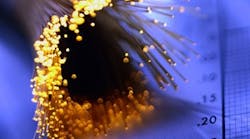"Fiber is fast, so it's mostly been used as a communications media," says Tracy Lenz, senior product support for Wago's I/O Systems and Advanced Electronics. "However, variable-frequency drives produce lots of electrical noise, and because their use is increasing, demand for fiberoptics for VFDs is growing, too."
Fiber is strong enough to go from switch to switch, so it's used in networks to go from supervisory domains, through IT router/server rooms, and onto other domains or router cabinets on plant floors, Lenz says. "Fiber is growing as a transition media between large clusters of Ethernet components and sub-networks because of its high bandwidth and long-run, no-noise capabilities," he says. "Fiber also shines in some mid-level and advanced switches with Xpress ring or Jet ring features in which data moves from copper to fiber. If Ethernet can't go far enough or wireless can't go where you want, then fiber probably can do it."
The expansion of Ethernet for mission-critical control applications brings with it the need for greater bandwidth requirements, according to Frank Koditek, product line manager, industrial cables, Belden Americas. "So there's increasing demand for Cat. 6 cabling along with fiberoptic solutions that will improve performance," he says. "Users are demanding maximum network availability, even where the environment would cause damage and failure to standard networking products."
As a result, Belden's Hirschmann and GarrettCom brands are integrating fiberoptic capabilities into every managed, unmanaged, DIN-rail-mounted and 19 in. rack-mounted switch they produce, reports Sven Burkhard, field solutions manager for Hirschmann. "Traditionally, media converters moved data from copper to fiber, but they didn't leave room for added ports," he says. "Now we have Ethernet switches with eight or 16 ports, including one, two or more fiber ports, and people are realizing they can use fiber ports like any other port. We've had fiber in our portfolio for 14 years, and it was Hirschmann that made the first fiber-Ethernet ring, but its use is increasing exponentially now. Users were already creating fiber backbones, but now they're getting fiber down to the plant floors and PLCs. It's still more costly, but fiberoptics is no longer a black magic, voodoo light carrier, and really is something that the average technical person can implement."
[pullquote]For example, Belden's two-year-old Brilliance fiberoptic connectors are pre-polished and can be connected in about a minute, and its two grades of Tactical fiberoptic cable include a moderately flexible version and a MaxiBend highly flexible version made from glass fiber aided by a dopant additive.
Likewise, Beckhoff Automation reports that fiberoptics' original advantages also make it useful in many wind-energy and other renewable applications. "Profibus, EtherCAT, Interbus, SERCOS and Lightbus protocols all have some fiberoptic components, so they'll be immune to EMFs and can go into high-noise areas such as grain elevators, ship-loading and mining applications," says Kurt Wadowick, Beckhoff's I/O specialist. "And, in the past five years, we're seeing a lot of our Lightbus couplers going into wind towers." These include plastic fiber couplers (Lightbus) and glass fiber couplers (EtherCAT). Wadowick adds that plastic fiber terminations are easier to sand and connect, but have only enough internal reflectivity to go about 50 m. Glass fiber connections are harder to polish, but can go 20,000 m in single-mode and 2,000 m in multi-mode.
"Fortunately, glass fiber is a lot better protected now, and has Kevlar coatings and plastic jackets, which allow it to stand up to dirt, chemicals, high temperatures, and other nasty environments," Wadowick adds. "Fiberoptics have become true industrial components. The only question is: Can users cut fiberoptic cabling and properly treat the connections? But even that challenge is met by pre-made components from many suppliers.
"Fiberoptics are still more expensive, complex and labor-intensive than copper, but distance and noise requirements can trump those costs. Also, better splicing and connections are bringing costs down; better-designed LED and laser transceivers are aiding speed and distance capabilities; and improved reflectivity and durability are making fiberoptics even more usable."






